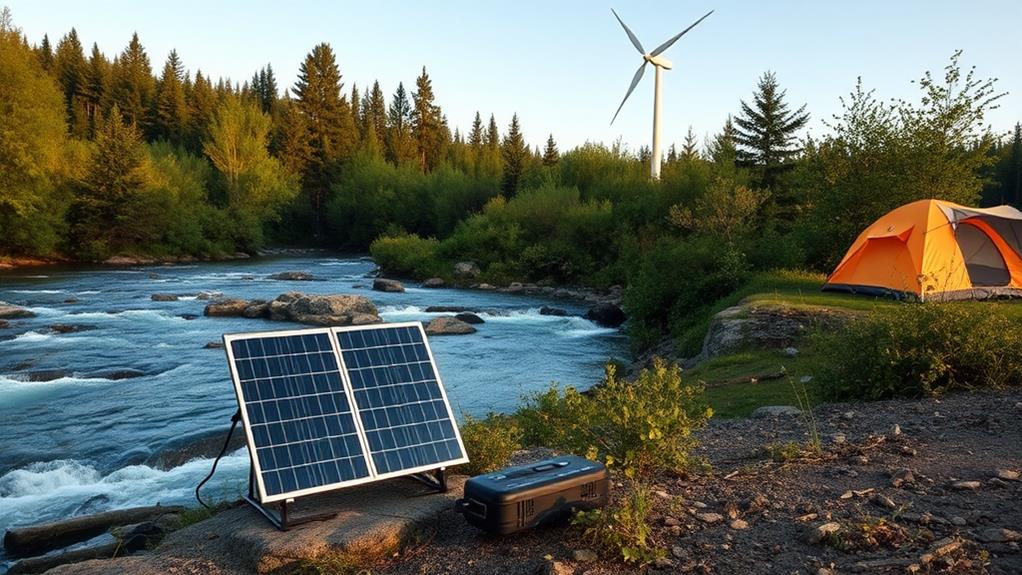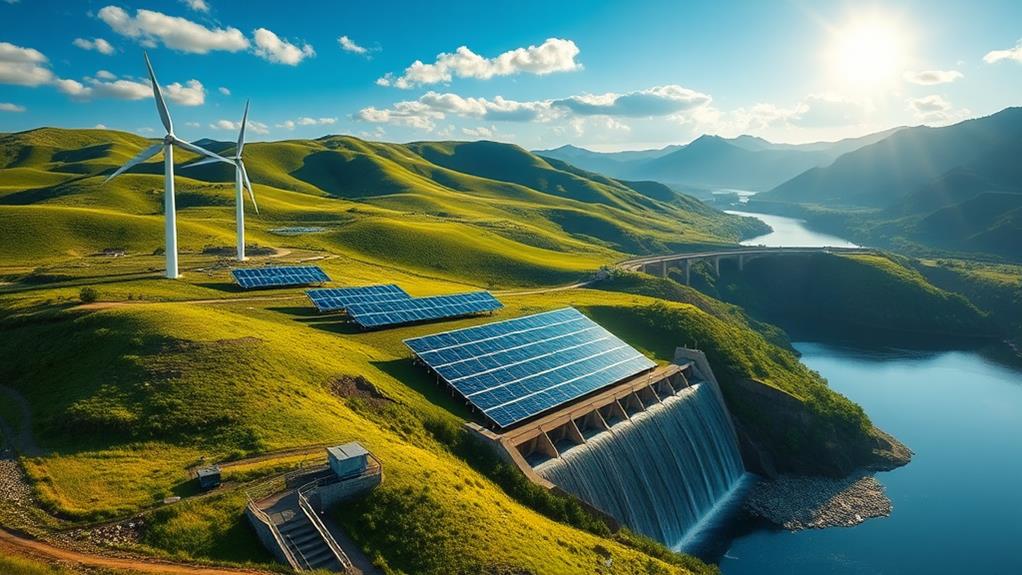Choosing a green generator for off-grid living allows us to harness renewable energy sources like solar, wind, or hydro, providing sustainable electricity while reducing our carbon footprint. These systems often have lower operating costs, minimal maintenance needs, and can generate annual savings on energy bills ranging from $500 to $1,000. Additionally, many green generators qualify for government incentives, potentially saving over 26% on initial investments. By adopting these technologies, we not only promote environmental stewardship but also enhance our energy independence. Exploring the various types of green generators further reveals how we can effectively meet our power needs sustainably.
Key Takeaways
- Green generators utilize renewable energy, significantly reducing carbon emissions and promoting environmental sustainability.
- They offer lower operating costs, eliminating ongoing fuel expenses and saving $500 to $1,000 annually on energy bills.
- Minimal maintenance requirements lead to fewer service interruptions, ensuring a reliable power supply for off-grid living.
- Many green generators are eligible for tax credits and incentives, reducing upfront costs by 26% or more.
- Investing in green generators can enhance property value while supporting climate change mitigation efforts.
Advantages of Green Generators
When we consider the move toward sustainable living, the advantages of green generators become clear. These systems, which utilize renewable energy sources like solar and wind, considerably reduce our carbon emissions, thereby lessening our overall environmental impact. As we embrace off-grid living, we find that green generators often come with lower operating costs, due to minimal fuel expenses and reduced energy bills over time. Additionally, they require minimal maintenance, eliminating the complexities of traditional fuel systems, which leads to fewer service interruptions. Furthermore, their quiet operation greatly minimizes noise pollution, enhancing our quality of life in residential areas. Finally, investing in green generators may qualify us for tax credits and incentives, further solidifying our commitment to sustainable energy solutions.
Types of Green Generators
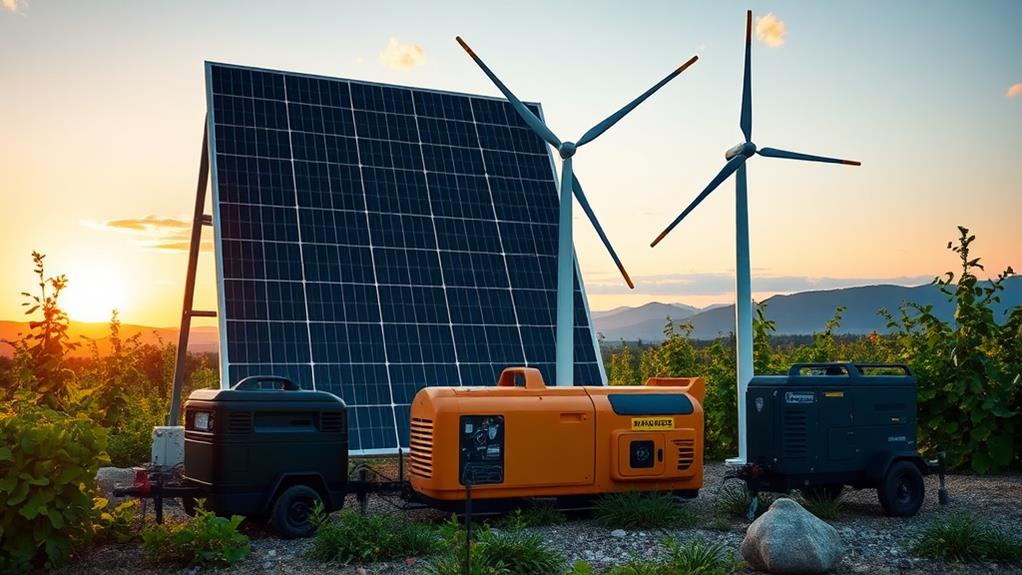
There are several types of green generators we can explore, each offering unique benefits for off-grid living. Understanding these options helps us make informed choices aligned with sustainable living principles.
- Solar Generators harness sunlight, ideal for sunny locales, with low maintenance costs.
- Wind Generators utilize natural wind energy, providing efficient power in areas with consistent wind patterns, often paired with solar systems.
- Hydro Generators generate electricity from flowing water, suitable for rivers or streams, ensuring continuous power with minimal impact.
- Biogas Generators convert organic waste into energy, serving as a sustainable waste management solution.
- Hybrid Generators combine solar, wind, and traditional fuels, optimizing energy production and reducing fossil fuel reliance.
Environmental Impact and Sustainability

As we shift to off-grid living, it's essential to recognize how green generators markedly reduce our carbon footprint by utilizing renewable energy sources like solar and wind, which produce little to no emissions. By adopting these technologies, we can minimize our reliance on finite fossil fuels, leading to long-term cost savings and a more sustainable lifestyle. Furthermore, with the lifespan of solar panels typically ranging from 25 to 30 years, we can guarantee consistent energy production while fostering environmental stewardship and resource conservation.
Carbon Footprint Reduction
Reducing our carbon footprint is crucial for a sustainable future, and green generators offer an effective solution. By utilizing renewable energy sources, we can markedly decrease our reliance on fossil fuels, thereby enhancing our off-grid living experience while protecting the environment.
Here are some key benefits of adopting green generators:
- Minimal greenhouse gas emissions during operation, leading to cleaner air.
- Reduction of carbon emissions by up to 80%, according to the U.S. Department of Energy.
- Conservation of natural resources for future generations through sustainable energy practices.
- Improved public health outcomes by minimizing air pollutants linked to respiratory issues.
- Support for climate change mitigation efforts, essential for achieving global emissions reduction targets.
Together, we can make a meaningful impact.
Renewable Energy Sources
While embracing renewable energy sources, we're not only making a choice for our own off-grid living but also for the planet's future. By integrating solar panels and wind systems into our energy solutions, we greatly reduce greenhouse gas emissions, thereby minimizing our carbon footprint. These renewable energy sources promote energy independence, allowing our off-grid homes to thrive sustainably. With solar generators converting sunlight into electricity at an efficiency of approximately 25% and wind generators harnessing natural wind energy, we have reliable options for energy generation. Additionally, the lifespan of solar panels, ranging from 25 to 30 years, offers a long-term solution that supports eco-friendly practices while aligning with global efforts to combat climate change and promote sustainability.
Long-Term Cost Savings
Investing in green generators like solar and wind power can lead to significant long-term cost savings for us as homeowners. By harnessing renewable energy, we dramatically cut long-term fuel costs, avoiding expensive fossil fuels. Additionally, the savings on energy bills can range from $500 to $1,000 annually, depending on our consumption and local utility rates. Moreover, many installations qualify for tax credits and incentives, which help offset initial costs, enhancing our overall savings. With minimal maintenance requirements and a lifespan of 25 to 30 years for solar panels, these systems provide a reliable backup power source, ensuring we're well-supported over time.
- Significant reduction in fuel costs
- Annual savings on energy bills
- Tax credits and incentives available
- Minimal maintenance required
- Long-lasting energy solutions
Cost Considerations for Off-Grid Living
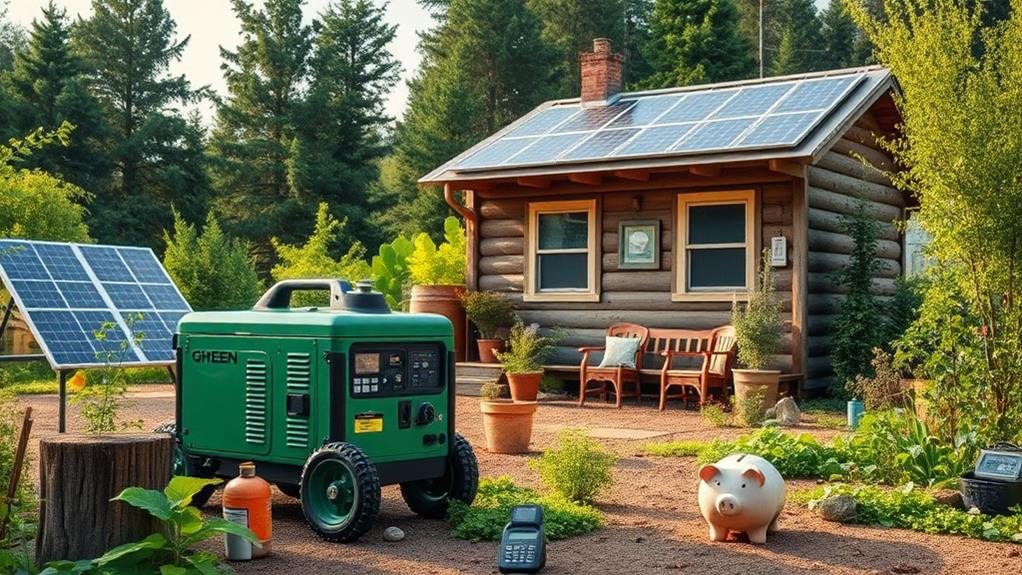
When we plunge into the cost considerations for off-grid living, the initial investment in green generators, such as solar or wind systems, can be a bit intimidating, with prices ranging from $1,000 to $20,000 based on capacity and technology. However, utilizing renewable energy sources can eliminate ongoing fuel costs, which typically average between $500 to $1,000 annually for traditional generators. Additionally, we can take advantage of government incentives and tax credits, potentially saving 26% or more on upfront costs. Importantly, maintenance costs for green generators are generally lower, particularly for solar systems that require minimal upkeep. As an added benefit, investing in these systems can enhance property value, making them an attractive option for those of us passionate about sustainability.
Key Features of Green Generators

There's no denying that green generators come packed with impressive features that make them ideal for off-grid living. These generators harness renewable energy sources, considerably lowering our carbon footprint. Key features that enhance their appeal include:
- Solar capabilities, allowing us to capture sunlight and convert it to electricity.
- Energy storage systems that enable us to store excess energy for later use, ensuring we remain powered even during low production periods.
- High efficiency, with solar generators typically operating between 15% to 25%, depending on conditions.
- Low maintenance needs, as solar panels can last 25 to 30 years with minimal upkeep.
- Smart technology integration, enabling real-time monitoring to optimize energy production and consumption.
Together, these features support our sustainable lifestyle choices.
Installation and Setup Guidelines

When setting up our off-grid generator system, it's essential we first assess our energy requirements, as this will guide us in selecting the right generator size and type to handle both peak demand and daily load. Additionally, choosing solar panels that align with our generator's specifications and placing them in locations that maximize sunlight exposure throughout the day will greatly enhance our energy collection efficiency. By adhering to manufacturer guidelines for installation, including proper wiring and connections, we can guarantee a safe and efficient system that meets our off-grid power needs.
Assess Energy Requirements
Evaluating our energy requirements is an essential step in setting up a green generator for off-grid living. To make informed decisions when selecting a backup generator, we need to calculate our total watt-hours for essential appliances, ensuring our power supply meets our needs.
Here are key considerations:
- Assess daily energy consumption and peak demand, which may reach up to 10kW.
- Determine the generator size based on our energy requirements.
- Choose solar panels with compatible output for maximum efficiency.
- Regularly check connections and equipment for ideal performance.
- Follow manufacturer guidelines during installation to maintain safety and efficiency.
Optimal Panel Placement
Maximizing our solar energy capture starts with ideal panel placement. For optimal panel placement, we should position our solar panels to face true south in the northern hemisphere or true north in the southern hemisphere, ensuring maximum energy capture throughout the day. The tilt angle, typically between 30° and 45°, should align with our latitude to enhance solar energy collection year-round. It's essential to avoid shading from nearby trees or structures, as even partial shade can greatly hinder efficiency. Additionally, by regularly adjusting the panel angle seasonally, we can enhance energy production by up to 25% during peak seasons. Finally, ensuring proper ventilation around the panels is critical to prevent overheating, maintaining efficiency and extending lifespan in our off-grid home.
Maintenance Tips for Longevity

Maintaining our green generator is essential for its longevity and overall performance. By implementing a few maintenance tips, we can guarantee that our power requirements are met efficiently and sustainably. Here are some key practices to follow:
- Regularly inspect and clean the air filter to optimize airflow.
- Perform oil changes every 50 to 100 hours of operation for engine health.
- Run the generator monthly for at least 30 minutes under load to prevent rust and corrosion.
- Store the generator in a clean, dry environment and use fuel stabilizers to prevent fuel degradation.
- Monitor battery technology, guaranteeing lithium batteries are cycled regularly to maximize their lifespan, often lasting up to 10 years with proper care.
Regular maintenance is the cornerstone of performance and reliability in our off-grid lifestyle.
Future of Renewable Energy Solutions
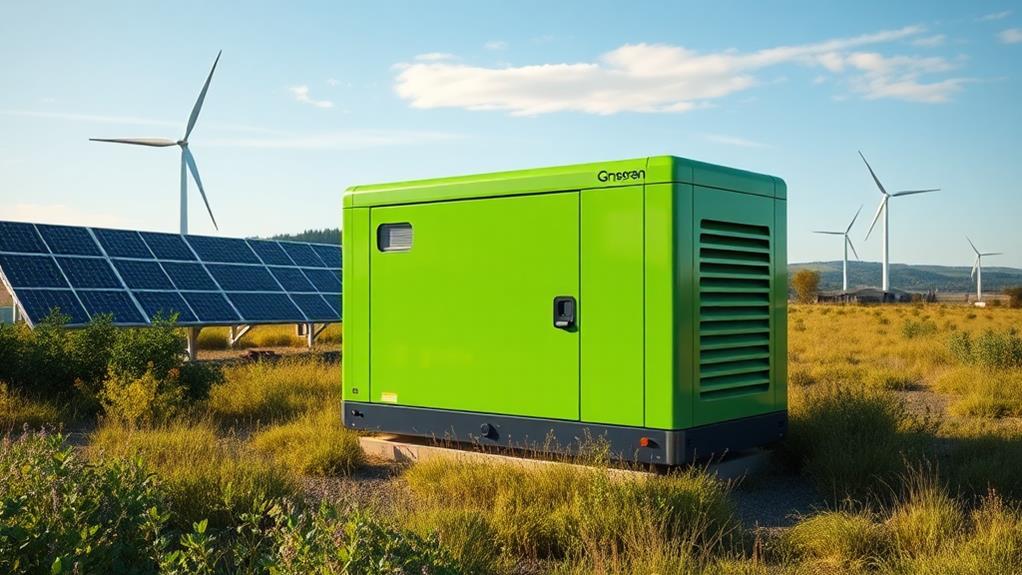
As we look ahead, it's clear that the future of renewable energy solutions is becoming increasingly promising, driven by our collective desire for sustainable living. The global renewable energy market is projected to grow at a CAGR of 8.4% through 2027, with renewable sources potentially accounting for nearly 50% of global electricity generation by 2030. With advancements in photovoltaic technology and energy storage solutions, solar energy installations are rising by over 20% annually, making solar backup generators more accessible. In addition, the International Energy Agency anticipates that renewable energy capacity will eclipse fossil fuels by 2025, while investments in this sector are expected to reach $2.6 trillion by 2025, reinforcing the commitment to off-grid living and sustainable practices.
Frequently Asked Questions
What Is the Best Power Source for Off-Grid Living?
When considering the best power source for off-grid living, we believe solar panels and wind turbines paired with efficient battery storage offer the perfect blend of energy efficiency and sustainability for our community's needs.
What Size Generator Do I Need to Live Off-Grid?
When we think about generator sizing, we must consider our energy efficiency and load calculations. By evaluating our lifestyle considerations, we can determine the right generator size to meet our off-grid needs effectively.
How Many Watts Do You Need to Live Off-Grid?
To live off-grid, we need to assess our energy consumption closely. Effective power management through solar integration and adequate battery storage guarantees we meet our demands while maintaining a sustainable lifestyle together.
What Is an Off-Grid Generator?
When we think of portable power, an off-grid generator shines like a beacon. With solar options and renewable energy, it dances to the tune of fuel efficiency, ensuring we thrive wherever our journey takes us.


